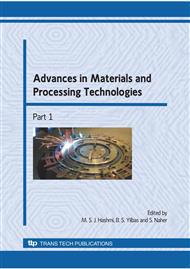p.449
p.457
p.465
p.473
p.481
p.489
p.497
p.505
p.524
Evaluation of the Role of Alloying Elements in Austemperability of Heavy Section Ductile Iron
Abstract:
In this investigation the role of alloying elements on austemperability of heavy section ductile irons was studied. Four different chemical compositions were chosen in a way to specify an optimal chemical composition with suitable austemperability. Austempering was carried out at 315 and 350oC for 1 hour on specimens prepared from cast Y-blocks with 75 mm thickness. Metallographic examinations and hardness tests indicated that thickness of bainitic layer was positively dependant on the amount of the alloying elements which deferred pearlitic transformation in TTT diagram to the longer time. In addition, by increasing the amount of alloying elements, the morphologies of ferrite in bainitic structure changed from featherlike to acicular. According to the results of this study, in order to achieve a full bainitic structure (in the specimens whit 75mm thickness), the optimal amounts of alloying elements were: 0.35 % Mn, 0.22 % Mo, 1.1-1.4% Ni and 0.6% Cu. In addition, regarding to the thick sections of Y-blocks, graphite degeneration defect was also studied, and it was noticed that this defect could be completely eliminated by adding 50ppm of antimony.
Info:
Periodical:
Pages:
481-487
Citation:
Online since:
December 2009
Keywords:
Price:
Сopyright:
© 2010 Trans Tech Publications Ltd. All Rights Reserved
Share:
Citation:


